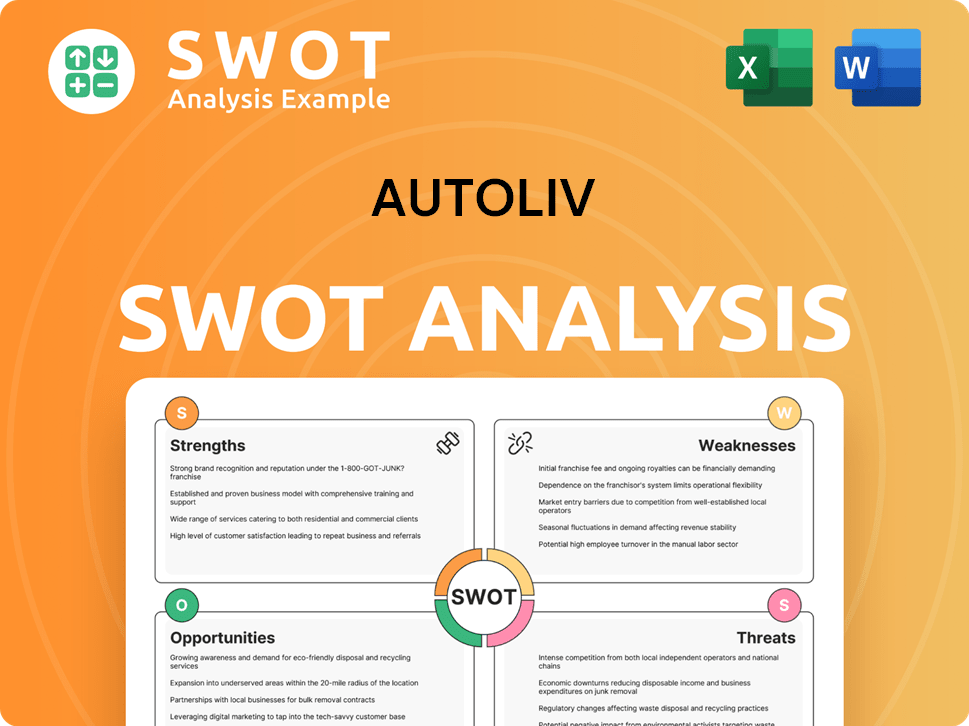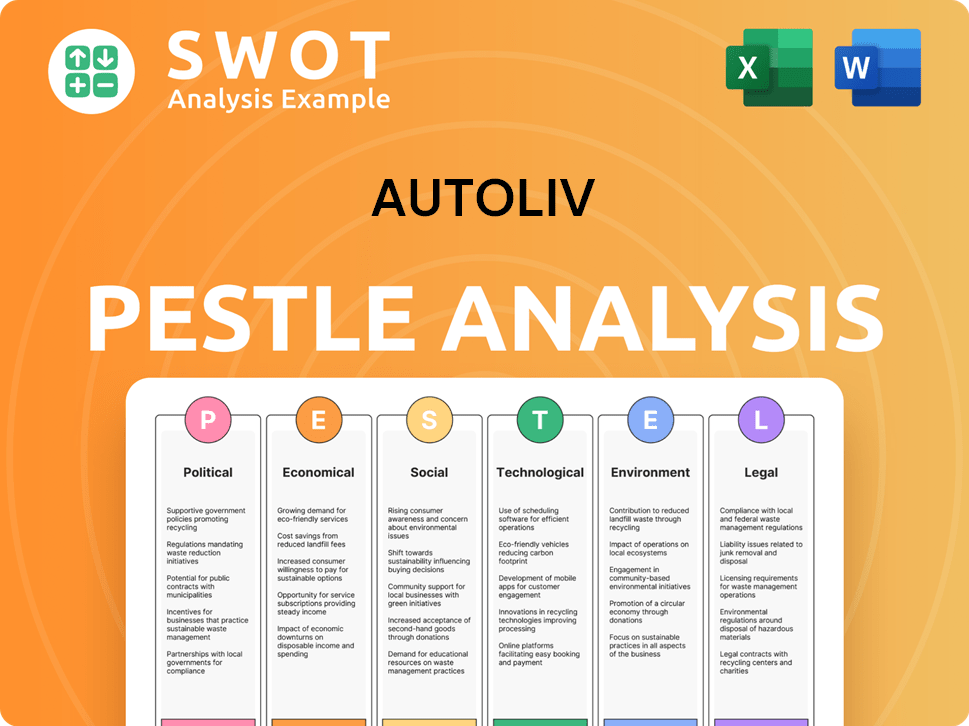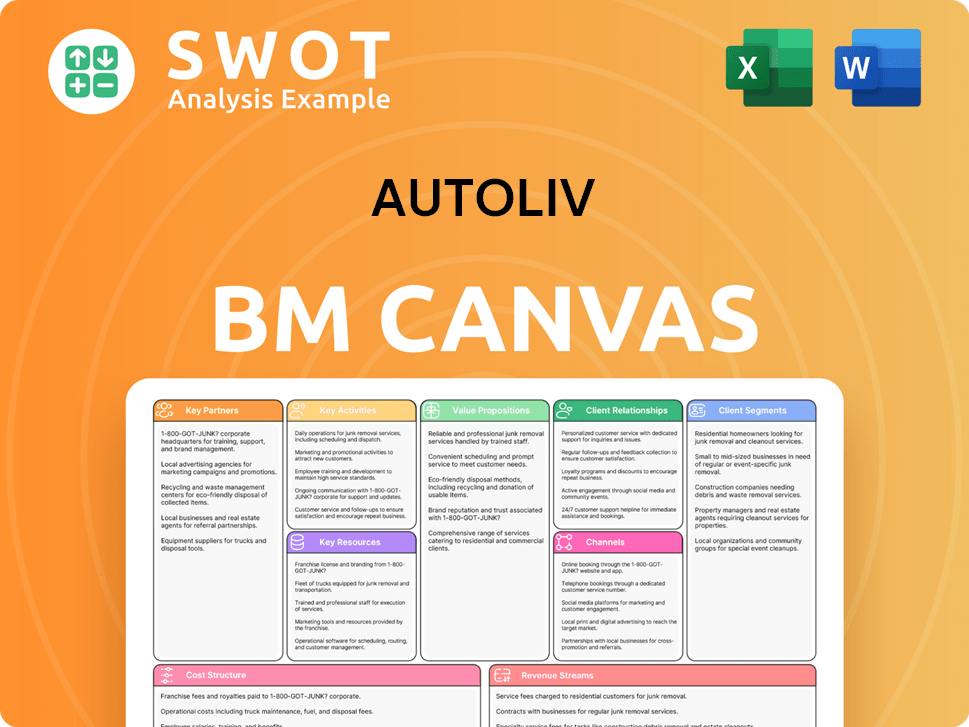Autoliv Bundle
Who Buys Safety? Unveiling Autoliv's Customer Demographics.
In the ever-evolving automotive landscape, understanding Autoliv SWOT Analysis is crucial for strategic success. This deep dive explores the customer demographics and target market that drive Autoliv's business, from its origins in seatbelt technology to its current focus on advanced driver-assistance systems (ADAS). We'll dissect the company's adaptation to shifting consumer expectations and the continuous evolution of vehicle technology.

This exploration goes beyond a simple market analysis; it's an examination of Autoliv's strategic approach to serving a diverse customer base. We'll analyze Autoliv's demographic data, including its key customer segments across North America, Europe, and Asia, and how the company refines its sales and marketing strategies. Understanding Autoliv's target audience analysis provides valuable insights into the competitive landscape and the company's future growth potential.
Who Are Autoliv’s Main Customers?
When analyzing the customer demographics and target market of Autoliv, it's crucial to understand its business model. Autoliv primarily operates in a business-to-business (B2B) model, focusing on major global automotive manufacturers. These manufacturers are the primary customers, influencing Autoliv's product development and sales strategies.
The target market for Autoliv is essentially the global automotive industry. This includes a wide array of car brands, from mass-market vehicles to luxury cars and commercial vehicles. Autoliv's success is closely tied to the production volumes of these manufacturers and the integration of advanced safety systems into new car models. Understanding these dynamics is key to performing a thorough market analysis of Autoliv.
Autoliv's sales are directly impacted by global vehicle production figures. The demand for its products, such as airbags and seatbelts, correlates with the number of vehicles manufactured worldwide. Factors like the adoption of new safety regulations and the shift towards electric vehicles (EVs) also significantly influence Autoliv's business. For more insights into Autoliv's business model, consider reading about the Revenue Streams & Business Model of Autoliv.
Autoliv's largest customer segments are concentrated in major automotive manufacturing hubs. These include Asia (particularly China and Japan), Europe, and North America. The company strategically aligns its operations with these key regions to serve its customers effectively. This geographical focus is crucial for understanding Autoliv's market share by region.
The fastest-growing segments for Autoliv are often tied to emerging markets. These markets experience increasing vehicle ownership and stricter safety regulations. The ongoing shift towards active safety systems and autonomous driving technologies also fuels growth. Autoliv continuously adapts its product portfolio to meet these evolving demands.
Autoliv has evolved its product offerings beyond traditional passive safety systems. The company now includes active safety solutions, such as radar and vision systems. This adaptation is essential to meet the changing needs of the automotive industry. This shift impacts Autoliv's market strategy.
While demographic data like age and income aren't directly applicable to Autoliv's B2B customers, they indirectly influence the types of safety features demanded. For instance, the growing popularity of SUVs and EVs affects the design of safety systems. These trends are important for understanding Autoliv's target audience analysis.
Autoliv's key customer segments are primarily global automotive manufacturers. These manufacturers drive the demand for Autoliv's products, influencing its revenue and strategic decisions. Understanding these segments is crucial for Autoliv's demographic profile.
- Mass-market passenger vehicle manufacturers.
- Luxury car manufacturers.
- Commercial vehicle manufacturers.
- Manufacturers in Asia (China, Japan).
- Manufacturers in Europe.
- Manufacturers in North America.
Autoliv SWOT Analysis
- Complete SWOT Breakdown
- Fully Customizable
- Editable in Excel & Word
- Professional Formatting
- Investor-Ready Format

What Do Autoliv’s Customers Want?
Understanding the customer needs and preferences is crucial for any business, and for the automotive safety supplier, it's paramount. The primary customers, automotive manufacturers (OEMs), have specific demands driven by safety regulations, cost considerations, and technological advancements. The ability to meet and exceed these expectations is vital for success in this competitive market.
The core focus for these OEMs is vehicle safety. They need to meet stringent global safety standards, such as those set by Euro NCAP, NHTSA, and C-NCAP. This directly impacts their brand reputation and consumer trust. This focus shapes their purchasing behaviors, emphasizing the reliability, performance, and integration capabilities of the safety systems.
Beyond safety, OEMs seek innovative solutions to differentiate their vehicles. This includes advanced driver-assistance systems (ADAS) and autonomous driving technologies. The psychological drivers for choosing products include the need for a trusted partner, ensuring the well-being of vehicle occupants. Practical drivers involve ease of integration, global supply chain reliability, and strong technical support.
Automotive manufacturers prioritize safety systems that meet or exceed global safety standards. This ensures high safety ratings for their vehicles, directly impacting their brand reputation and consumer trust.
OEMs seek innovative solutions to differentiate their vehicles in the market. This includes advanced driver-assistance systems (ADAS) and autonomous driving technologies, driving the demand for cutting-edge safety features.
Cost is a significant factor in the automotive industry. OEMs are always looking for cost-effective solutions that don't compromise on safety or quality. This includes the need for lightweight and compact solutions.
Ease of integration of safety systems into vehicle platforms is crucial. OEMs prefer solutions that are easy to install and integrate, reducing complexity and time-to-market.
The reliability and performance of safety systems are non-negotiable. OEMs demand products that consistently perform under various conditions, ensuring the safety of vehicle occupants. This is the core of the customer needs.
A reliable global supply chain is essential. OEMs need a consistent supply of components to maintain production schedules. This is a key factor in their decision-making process.
The company addresses common pain points by simplifying the integration of diverse safety technologies and providing lightweight, compact solutions. Feedback from automotive manufacturers and market trends, particularly the rapid advancements in ADAS and autonomous driving, heavily influence product development. This leads to continuous innovation in areas like advanced airbag designs, smarter seatbelt systems, and sophisticated sensor technologies. For instance, the company tailors its product features to specific vehicle segments, offering specialized safety solutions for compact cars versus luxury vehicles, and adapting to regional preferences in safety technology adoption. The company's focus on innovation is evident in its R&D spending, which amounted to approximately $900 million in 2023, reflecting its commitment to developing advanced safety systems. In 2024, the company's sales are projected to be around $9.5 billion, with a significant portion attributed to its active safety products, demonstrating its market leadership and ability to meet the evolving needs of its customers.
The primary needs of automotive manufacturers, the company's customers, revolve around safety, compliance, and innovation. These needs drive the demand for advanced safety systems.
- Safety Standards: Meeting and exceeding global safety standards (Euro NCAP, NHTSA, C-NCAP).
- Technological Innovation: Offering advanced solutions like ADAS and autonomous driving technologies.
- Cost-Effectiveness: Providing cost-efficient and lightweight solutions.
- Integration: Ensuring ease of integration into vehicle platforms.
- Reliability: Delivering reliable and high-performing safety systems.
- Supply Chain: Maintaining a reliable global supply chain.
Autoliv PESTLE Analysis
- Covers All 6 PESTLE Categories
- No Research Needed – Save Hours of Work
- Built by Experts, Trusted by Consultants
- Instant Download, Ready to Use
- 100% Editable, Fully Customizable

Where does Autoliv operate?
The geographical market presence of Autoliv is extensive, strategically aligning with the major automotive manufacturing hubs worldwide. The company's focus is primarily on regions with high vehicle production and sales, ensuring a strong global footprint. This strategic approach allows for efficient distribution and localized support for its automotive safety systems.
Key markets for Autoliv include Asia, particularly China and Japan, which are significant contributors to global vehicle production. Europe is another core market, with a substantial presence in countries like Germany, France, and Sweden, home to numerous leading automotive OEMs. North America, encompassing the United States, Canada, and Mexico, also forms a crucial market due to its large automotive industry.
Autoliv's market share and brand recognition are strong within these regions. Its ability to adapt to regional differences in customer demographics, preferences, and buying power influences the types of safety features offered. For example, emerging markets may prioritize cost-effective passive safety solutions, while mature markets often demand advanced active safety features. Autoliv's marketing strategy is tailored to these regional demands.
Autoliv's market analysis involves understanding the unique needs of each region. This includes assessing local regulations, consumer preferences, and the competitive landscape. This helps in customizing products and services to meet specific regional demands, ensuring a competitive edge.
Demographic data plays a crucial role in shaping Autoliv's product offerings. Factors such as age, income levels, and cultural preferences influence the demand for specific safety features. For instance, higher-income markets may show greater interest in advanced driver-assistance systems (ADAS).
Autoliv segments its customer base based on factors like geographic location, vehicle type, and safety feature requirements. This segmentation allows for targeted marketing and product development efforts. Understanding these segments helps Autoliv tailor its offerings effectively.
The target market for airbags and seatbelts includes all automotive manufacturers globally. The demand for these core safety products remains consistently high. Autoliv continuously innovates to meet evolving safety standards and consumer expectations in this segment.
Autoliv's strategic presence is supported by manufacturing facilities and technical centers in key regions. This localization enables the company to provide localized support, adapt products to regional vehicle platforms, and comply with local regulations. This approach ensures responsiveness to customer needs and market dynamics.
- Asia: Strong presence in China and Japan, reflecting the region's high vehicle production volume.
- Europe: Significant market share in Germany, France, and Sweden, serving major automotive OEMs.
- North America: Core market including the United States, Canada, and Mexico, with a focus on the large automotive industry.
- Global Reach: Autoliv's sales and growth are geographically distributed, aligning with global vehicle production trends.
Autoliv Business Model Canvas
- Complete 9-Block Business Model Canvas
- Effortlessly Communicate Your Business Strategy
- Investor-Ready BMC Format
- 100% Editable and Customizable
- Clear and Structured Layout

How Does Autoliv Win & Keep Customers?
Autoliv's customer acquisition and retention strategies are deeply rooted in its business-to-business (B2B) model, focusing on long-term partnerships with automotive manufacturers. The company's approach is centered on trust, innovation, and reliability, which are critical in the automotive safety systems industry. This strategic focus allows Autoliv to build lasting relationships with its customers.
The primary goal for Autoliv is to establish and maintain strong relationships with automotive original equipment manufacturers (OEMs). This involves early engagement in the vehicle design process, collaborating closely with manufacturers to integrate its technologies. This collaborative approach ensures that Autoliv's products meet the specific needs of its customers and contribute to vehicle safety.
Customer acquisition is achieved through direct sales efforts, participation in industry events, and proactive outreach to automotive OEMs. Autoliv's presence at trade shows and conferences allows it to showcase its latest innovations and connect with potential customers. These efforts are integral to the company's strategy for expanding its customer base and reinforcing its market position.
Autoliv employs a direct sales approach, engaging with automotive manufacturers to understand their needs and offer tailored solutions. Participation in industry trade shows and technical conferences is crucial for showcasing innovations and networking with potential customers. These events provide opportunities to build relationships and generate leads.
Autoliv often gets involved early in the vehicle design process, working closely with OEMs to integrate its safety technologies. This collaborative approach ensures that Autoliv's products are specifically designed to meet the needs of each vehicle model. Early involvement enhances the likelihood of long-term partnerships.
Continuous product innovation is a cornerstone of Autoliv's retention strategy, ensuring the company remains at the forefront of automotive safety technology. This includes developing advanced driver-assistance systems (ADAS) and other safety solutions. Innovation helps meet the evolving demands of customers and maintain a competitive edge.
Providing exceptional technical support and maintaining consistent product quality are critical for retaining customers. Autoliv's commitment to quality and reliability builds trust and reinforces customer loyalty. This includes ensuring a reliable supply chain to meet the demands of automotive manufacturers.
Retention strategies emphasize continuous product innovation, exceptional technical support, and reliable supply chain management. Autoliv leverages customer data to personalize offerings and provide tailored solutions, ensuring it meets the specific needs of its customers. The company's reputation for quality and safety is a key factor in customer loyalty, with many of these relationships spanning decades. The success of these strategies is evident in Autoliv's long-standing relationships with major automotive manufacturers, solidifying its position as a trusted supplier of essential safety components.
Autoliv primarily operates within a B2B model, focusing on long-term partnerships with automotive manufacturers. This strategy allows for deeper collaboration and tailored solutions, building trust and mutual success. This approach is key for retaining customers.
Autoliv utilizes customer data, including vehicle platform information and future product roadmaps, to customize its offerings. This data-driven approach enables the company to provide personalized solutions and meet the specific needs of its clients. This ensures that Autoliv can meet the evolving demands of the automotive market.
Autoliv's commitment to quality and safety is a major factor in customer loyalty, reinforcing its reputation as a reliable supplier. This commitment is crucial in the automotive industry, where safety is paramount. Autoliv's focus on quality is critical for maintaining customer relationships.
Successful retention is evident in Autoliv's long-standing relationships with major automotive manufacturers. These enduring partnerships highlight the company's ability to deliver essential safety components consistently. These relationships are built on trust and mutual success.
While traditional marketing is less prevalent, Autoliv uses industry publications, technical conferences, and direct communication to engage with customers. These channels are crucial for staying connected with clients and promoting innovations. This approach ensures that Autoliv remains visible to its target audience.
Autoliv continuously seeks to improve its products and services to meet the changing needs of its customers. This includes investing in research and development to stay ahead of industry trends. This commitment to improvement helps maintain customer satisfaction and loyalty.
Autoliv's customer acquisition and retention strategies are reflected in its financial performance and market share. The company's ability to secure long-term contracts and maintain strong relationships with major automotive manufacturers is a key indicator of success. For example, in 2024, Autoliv reported net sales of approximately $9.3 billion, demonstrating its strong market position and customer relationships. Furthermore, Autoliv's strategic focus on safety and innovation has allowed it to maintain a significant market share in the automotive safety systems sector. You can learn more about the company's financial health by reading Owners & Shareholders of Autoliv.
- $9.3 Billion: Autoliv's net sales in 2024.
- Long-term contracts: A key indicator of successful customer acquisition.
- Market Share: Maintaining a significant share in the automotive safety systems sector.
- Customer Retention Rate: High retention rates reflect customer satisfaction and loyalty.
Autoliv Porter's Five Forces Analysis
- Covers All 5 Competitive Forces in Detail
- Structured for Consultants, Students, and Founders
- 100% Editable in Microsoft Word & Excel
- Instant Digital Download – Use Immediately
- Compatible with Mac & PC – Fully Unlocked

Related Blogs
- What are Mission Vision & Core Values of Autoliv Company?
- What is Competitive Landscape of Autoliv Company?
- What is Growth Strategy and Future Prospects of Autoliv Company?
- How Does Autoliv Company Work?
- What is Sales and Marketing Strategy of Autoliv Company?
- What is Brief History of Autoliv Company?
- Who Owns Autoliv Company?
Disclaimer
All information, articles, and product details provided on this website are for general informational and educational purposes only. We do not claim any ownership over, nor do we intend to infringe upon, any trademarks, copyrights, logos, brand names, or other intellectual property mentioned or depicted on this site. Such intellectual property remains the property of its respective owners, and any references here are made solely for identification or informational purposes, without implying any affiliation, endorsement, or partnership.
We make no representations or warranties, express or implied, regarding the accuracy, completeness, or suitability of any content or products presented. Nothing on this website should be construed as legal, tax, investment, financial, medical, or other professional advice. In addition, no part of this site—including articles or product references—constitutes a solicitation, recommendation, endorsement, advertisement, or offer to buy or sell any securities, franchises, or other financial instruments, particularly in jurisdictions where such activity would be unlawful.
All content is of a general nature and may not address the specific circumstances of any individual or entity. It is not a substitute for professional advice or services. Any actions you take based on the information provided here are strictly at your own risk. You accept full responsibility for any decisions or outcomes arising from your use of this website and agree to release us from any liability in connection with your use of, or reliance upon, the content or products found herein.